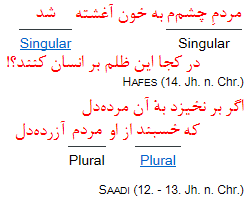The number grammatical category of a verb phrase indicates in principle whether an action or a situation is assigned to one (= singular) or several entities (= plural).
a. Syntax
The number of conjugated Persian verb phrases is determined by the following constituents:
- Suppletive verbs for conjugated perfect and presumptive participles:
دوش چه خوردهای (singular) بتا؟ راست بگو! نهان مکن!
چون خمشانِ بیگنه روی بر آسمان مکن!
Rumi (13th Century AD)
کهاز نیستان تا مرا ببریدهاند (plural)
از نفیرم مرد و زن نالیدهاند (plural)
Rumi (13th Century AD)
- Verbal inflectional suffixes for conjugated past and present participles:
در رفتنِ جان از بدن گویند (plural) هر نوعی سخن
من خود به چشمِ خویشتن دیدم (singular) که جانم میرود (Singular)
Saadi (12th and 13th Century AD)
In Persian, verb phrases which are not conjugated in a certain subcategory of number, can be noted only in the application of perfect participle as predicate (in copulative coordination of inflectional phrases) (see 12•۴•b.):
پرونده را تکمیل کرده (plural) به بایگانی باز گردانید!
b. Verbal Concord and Discord in the Number
(See 13•۵•b. Verbal Concord and Discord in the Polarity and 13•۷•b. Verbal Concord and Discord in the Person.)
Verbal concord in the number means that the subject (a noun phrase) and the predicate (a verb phrase) are in the same number subcategory in a sentence:
Verbal discord in the number describes the case where the number of a verb phrase does not match the quantity of entities the action or situation is assigned to. This occurence is regularly noted in modern idioms of Persian in the following cases:
-
Plural of majesty: Discord in the number for single persons in the singular for respect:
حضرتِ خواجهیِ ما اگر به منزلِ درویشی میرفتند، جمیعِ فرزندان و متعلّقان و خادمانِ او را پرسش میکردند.
From the book “Anis ol-Talebin” of Salah Bukhari (14th Century AD)
و چون حضرتِ امیر به شهرِ سمرقند در آمدند، به حسبِ اتّفاق گذرِ ایشان بر درِ ارک افتاده.
Khond Mir (16th Century AD)
-
Plural of modesty: Discord in the number for the 1st person singular as a sign of the modesty:
یاد آن وقت که ما دلشده را یاری بود
هر کسی را به سرِ کویِ کسی کاری بود
Hayati Gilani (17th Century AD)
-
One feature of Persian language is the optional discord in the number for inanimates in the plural:
رمزوان و داذین و دوان چند نواحی است از اعمالِ اردشیرخوره، و همه گرمسیر است.
Ebn-e Balkhi (11th and 12th Century AD)
جز در دلِ خاک هیچ منزلگه نیست
می خور! که چنین فسانهها کوته نیست
Omar Khayyam (11th and 12th Century AD)
نه دهقان، نه ترک و نه تازی بود
سخنها به کردارِ بازی بود
Ferdowsi (10th and 11th Century AD)
سایهیِ طوبی و دلجوییِ حور و لبِ حوض
به هوایِ سرِ کویِ تو برفت از یادم
Hafez (14th Century AD)
-
Another feature of this language is that the following pronouns appear in the 3rd person singular, while the predicate conforms to the number and the person of the superset and can cause a verbal discord:
- Distributive pronouns (see 7•۸•b•a.):
هر یک در گوشهای سنگر بگیرید!
هر کدام در کشوری از جهان به سر میبریم.
- Inexistential pronouns (see 7•۱۰•b.):
هیچ یک نایِ حرف زدن نداشتیم.
هیچ کدام تمایلی به این کار ندارید.
- Selective pronouns (see 7•۱۱.):
یک کدام به مادرتان کمک کنید!
یک کدام جانشینِ آقایِ رییس میشویم.
It is interesting that the predicate becomes concordant (in the 3rd person singular), if the superset attributes the pronoun as an origative adverbial:
یک کدام از شما به مادرتان کمک کند!
از ما کارمندانِ قدیمی یک کدام جانشینِ آقایِ رییس میشود.
هر یک از شما در گوشهای سنگر بگیرد!
از ما ایرانیان هر کدام در کشوری از جهان به سر میبرد.
هیچ یک از ما نایِ حرف زدن نداشت.
هیچ کدام از شما تمایلی به این کار ندارد.
- Distributive pronouns (see 7•۸•b•a.):
In addition, the following discords in the number can be noted in archaic idioms of Persian:
-
Discord in the number for animates in the plural:
آدم و حوّا بمرد و نوح و ابراهیمِ خلیل بمرد.
Attar Nishapuri (12th and 13th Century AD)
یکی پاکخوان از درِ مهتران
خورشها بیاراست خوالیگران
Ferdowsi (10th and 11th Century AD)
-
The predicate of the second conjunct is used in the singular, if both sentences have the same subject in the plural in copulative coordination of inflectional phrases:
هر دیهی را چند نوبت کشش و غارت کردند و سالها آن تشویش بر داشت.
Djovaini (13th Century AD)
چون نیمهشب بود بار بر نهادند و برفت.
Balami (10th Century AD)
- The attributive distributive pronoun /hær ke/ هر که is in the singular, but it is also used with predicates in the plural (see 7•۸•b•b.):
بدان که هر که در لشکرِ تو اند، بر تو جاسوسانند!
Nasrollah Monshi (12th Century AD)
به هندوستان هر که دانا بُدند
به گفتار و دانش توانا بُدند
Ferdowsi (10th and 11th Century AD)


